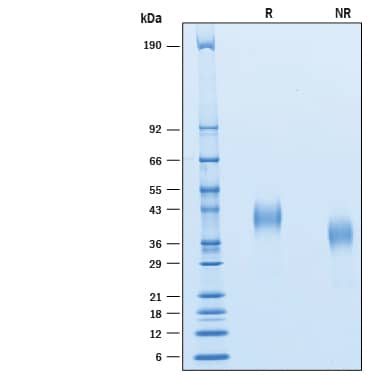Recombinant Cynomolgus Monkey CD7 His-tag Protein, CF
R&D Systems, part of Bio-Techne | Catalog # 10214-CD

Key Product Details
Product Specifications
Source
Human embryonic kidney cell, HEK293-derived cynomolgus monkey CD7 protein
Ala26-Pro180, with C-terminal 6-His tag
Ala26-Pro180, with C-terminal 6-His tag
Purity
>95%, by SDS-PAGE visualized with Silver Staining and quantitative densitometry by Coomassie® Blue Staining.
Endotoxin Level
<0.10 EU per 1 μg of the protein by the LAL method.
N-terminal Sequence Analysis
Ala26
Predicted Molecular Mass
17 kDa
SDS-PAGE
37-44 kDa, under reducing conditions
Activity
Measured by its binding ability in a functional ELISA.
When Recombinant Human SECTM1 Fc Chimera (Catalog # 7559-ST) is immobilized at 0.5 μg/mL (100 μL/well), the concentration of Recombinant Cynomolgus Monkey CD7 that produces 50% of the optimal binding response 8-40 ng/mL.
When Recombinant Human SECTM1 Fc Chimera (Catalog # 7559-ST) is immobilized at 0.5 μg/mL (100 μL/well), the concentration of Recombinant Cynomolgus Monkey CD7 that produces 50% of the optimal binding response 8-40 ng/mL.
Scientific Data Images for Recombinant Cynomolgus Monkey CD7 His-tag Protein, CF
Recombinant Cynomolgus Monkey CD7 His-tag Protein Binding Activity
When Recombinant Human SECTM1 Fc Chimera (Catalog # 7559-ST) is immobilized at 0.5 µg/mL, Recombinant Cynomolgus Monkey CD7 His-tag (Catalog # 10214-CD) binds with an ED50 of 8-40 ng/mL.Recombinant Cynomolgus Monkey CD7 His-tag Protein SDS-PAGE
2 μg/lane of Recombinant Cynomolgus Monkey CD7 His-tag (Catalog # 10214-CD)was resolved with SDS-PAGE under reducing (R) and non-reducing (NR) conditions and visualized by Coomassie® Blue staining, showing bands at 37-44 kDa and 30-40 kDa, respectively.Formulation, Preparation and Storage
10214-CD
| Formulation | Lyophilized from a 0.2 μm filtered solution in PBS. |
| Reconstitution | Reconstitute at 250 μg/mL in PBS. |
| Shipping | The product is shipped at ambient temperature. Upon receipt, store it immediately at the temperature recommended below. |
| Stability & Storage | Use a manual defrost freezer and avoid repeated freeze-thaw cycles.
|
Background: CD7
References
- Sutherland, D.R. et al. (1984) J. Immunol. 133:327.
- Aruffo, A. and B. Seed (1987) EMBO J. 6:3313.
- Shimizu, Y. et al. (1992) J. Exp. Med. 175:577.
- Rabinowich, H. et al. (1994) J. Immunol. 152:517.
- Chabannon, C. et al. (1992) J. Immunol. 149:2110.
- Grumayer, E.R. et al. (1991) Blood 77:64.
- Aandahl, E.M. et al. (2003) J. Immunol. 170:2349.
- Lazarovits, A.I. et al. (1994) J. Immunol. 153:3956.
- Lyman, S.D. et al. (2000) J. Biol. Chem. 275:3431.
- Wang, T. et al. (2012) J. Leukoc. Biol. 91:449.
- Carrera, A.C. et al. (1988) J. Immunol. 141:1919.
- Rabinowich, H. et al. (1994) J. Immunol. 153:3504.
- Pace, K.E. et al. (2000) J. Immunol. 165:2331.
- Sato, A.I. et al. (1994) J. Immunol. 152:5142.
Alternate Names
CD7, LEU-9, TP41
Gene Symbol
CD7
UniProt
Additional CD7 Products
Product Documents for Recombinant Cynomolgus Monkey CD7 His-tag Protein, CF
Product Specific Notices for Recombinant Cynomolgus Monkey CD7 His-tag Protein, CF
For research use only
